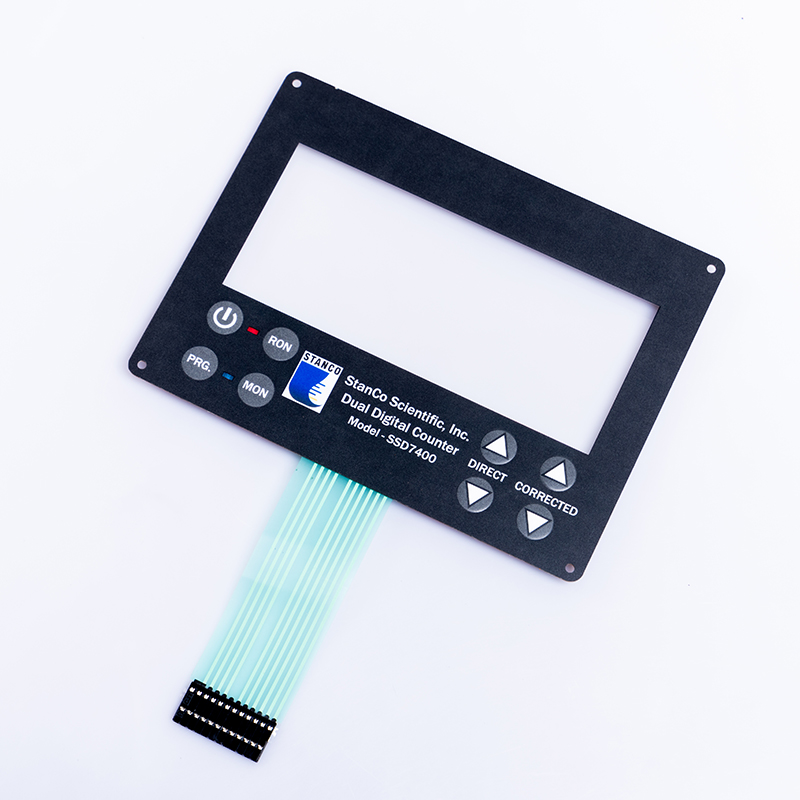Tactile & Non-Tactile Membrane Switches: Revolutionizing User Interfaces
What are TACTILE & NON-TACTILE MEMBRANE SWITCHES?
A TACTILE & NON-TACTILE MEMBRANE SWITCH is a type of user interface that utilizes a thin, flexible membrane to detect and transmit user inputs to an electronic device. It consists of multiple layers, including a graphic overlay, a spacer, and a circuit. These layers work together to provide a tactile or non-tactile feedback response when a user presses a designated area on the switch.
TACTILE MEMBRANE SWITCHES
TACTILE MEMBRANE SWITCHES are designed to provide users with a psical feedback response upon pressing. When a user applies pressure on a tactile membrane switch, it produces a satisfying click or tactile sensation, letting the user know that their input has been registered. This tactile feedback enhances the user experience by providing a sense of confirmation.
NON-TACTILE MEMBRANE SWITCHES
On the other hand, NON-TACTILE MEMBRANE SWITCHES do not offer a psical feedback response upon pressing. Instead, they rely on visual or auditory cues to indicate input registration. These switches are commonly used in applications where a silent operation or a sleek and seamless design is desired.
Advantages of TACTILE & NON-TACTILE MEMBRANE SWITCHES
TACTILE & NON-TACTILE MEMBRANE SWITCHES offer numerous advantages over traditional switches, making them a popular choice in various industries. Let’s explore some of these advantages:
1.Compact Design: TACTILE & NON-TACTILE MEMBRANE SWITCHES are incredibly thin and lightweight, allowing for easy integration into devices with limited space. Their compact design makes them suitable for applications where size and weight are critical factors.
2.Durability: Membrane switches are highly durable and resistant to environmental factors such as dust, moisture, and temperature fluctuations. This durability ensures a long lifespan, even in harsh operating conditions.
3.Customizability: TACTILE & NON-TACTILE MEMBRANE SWITCHES offer extensive customization options, including various shapes, sizes, colors, and graphic designs. This flexibility enables manufacturers to tailor the switches to meet specific branding or functional requirements.
4.Sealed Construction: The sealed construction of membrane switches provides excellent protection against liquid or debris ingress. This feature makes them ideal for applications in industries such as medical, automotive, and aerospace, where giene and cleanliness are paramount.
5.Cost-Effectiveness: TACTILE & NON-TACTILE MEMBRANE SWITCHES are cost-effective compared to other switch technologies. Their simplified construction and production process result in lower manufacturing costs, making them an economical choice for mass production.
6.Easy Integration: These switches can be easily integrated into various electronic devices, thanks to their flexible nature and compatibility with different circuitry and components. The ease of integration reduces assembly time and simplifies the overall manufacturing process.
Applications of TACTILE & NON-TACTILE MEMBRANE SWITCHES
TACTILE & NON-TACTILE MEMBRANE SWITCHES find applications in a wide range of industries and products. Let’s explore some of the common applications where these switches are used:
Consumer Electronics
In consumer electronics, TACTILE & NON-TACTILE MEMBRANE SWITCHES are widely employed in devices such as smartphones, tablets, remote controls, and gaming consoles. Their sleek design, durability, and responsive feedback make them an excellent choice for user-friendly interfaces.
Medical Equipment
In the medical field, membrane switches are utilized in equipment like medical devices, diagnostic instruments, and laboratory equipment. The sealed construction of these switches ensures gienic operation and ease of cleaning, critical requirements in medical environments.
Automotive
TACTILE & NON-TACTILE MEMBRANE SWITCHES are extensively used in automotive applications, including dashboard controls, infotainment systems, and control panels. The switches’ ability to withstand temperature variations, moisture, and vibrations makes them highly suitable for the demanding automotive environment.
Industrial Equipment
Industrial equipment often requires robust and reliable user interfaces, and TACTILE & NON-TACTILE MEMBRANE SWITCHES meet these requirements effectively. They are used in machinery control panels, automation systems, and manufacturing equipment, providing intuitive and durable interfaces for operators.
FAQs about TACTILE & NON-TACTILE MEMBRANE SWITCHES
1. What is the main difference between tactile and non-tactile membrane switches?
TACTILE MEMBRANE SWITCHES provide psical feedback, such as a click or tactile sensation, upon pressing, while NON-TACTILE MEMBRANE SWITCHES rely on visual or auditory cues for input registration.
2. Are TACTILE & NON-TACTILE MEMBRANE SWITCHES customizable?
Yes, TACTILE & NON-TACTILE MEMBRANE SWITCHES offer extensive customization options, including shape, size, color, and graphic design, allowing manufacturers to tailor them to their specific requirements.
3. Can TACTILE & NON-TACTILE MEMBRANE SWITCHES withstand harsh environments?
Yes, membrane switches are highly durable and resistant to environmental factors such as dust, moisture, and temperature fluctuations, making them suitable for use in harsh environments.
4. What industries commonly use TACTILE & NON-TACTILE MEMBRANE SWITCHES?
TACTILE & NON-TACTILE MEMBRANE SWITCHES are commonly used in industries such as consumer electronics, medical equipment, automotive, and industrial equipment.
5. How are TACTILE & NON-TACTILE MEMBRANE SWITCHES integrated into electronic devices?
TACTILE & NON-TACTILE MEMBRANE SWITCHES can be easily integrated into electronic devices due to their flexible nature and compatibility with different circuitry and components. They are often assembled during the manufacturing process.
6. Are TACTILE & NON-TACTILE MEMBRANE SWITCHES cost-effective?
Yes, TACTILE & NON-TACTILE MEMBRANE SWITCHES are cost-effective compared to other switch technologies. Their simplified construction and production process result in lower manufacturing costs, making them an economical choice for mass production.
Conclusion
TACTILE & NON-TACTILE MEMBRANE SWITCHES have revolutionized user interfaces, providing a seamless and intuitive interaction experience in various electronic devices. Their compact design, durability, customizability, and ease of integration make them a popular choice across industries such as consumer electronics, medical equipment, automotive, and industrial equipment. Whether it’s the satisfying tactile feedback or the sleek silent operation, these switches have become an integral part of our daily lives.
Professional technical engineer dedicated to guide you
According to your actual needs, choose the most reasonable overall design and planning procedures
